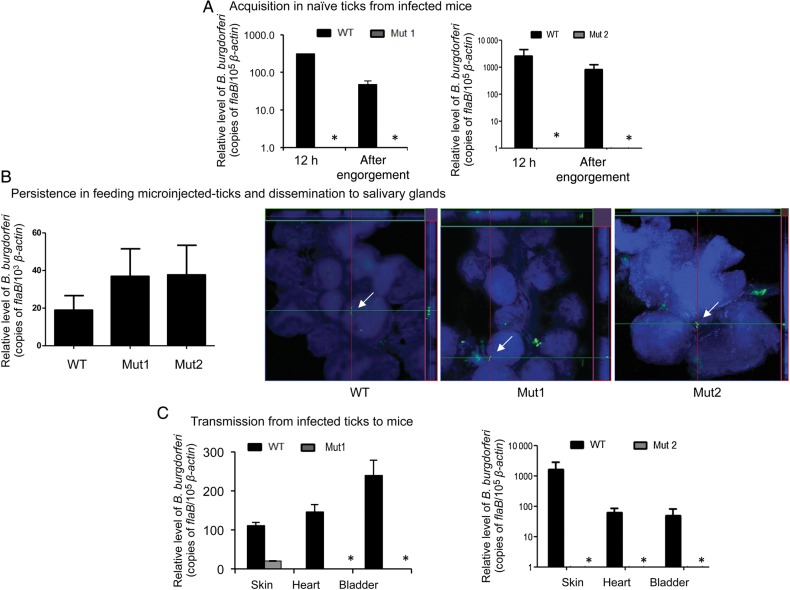Figure 4.
Deletion of bb0405 attenuates spirochete ability to transit between ticks and mice without affecting their ability to invade tick salivary glands. A, Borrelia burgdorferi burdens in fed ticks during pathogen acquisition. Naive Ixodes scapularis nymphs (30 ticks/group) were allowed to feed on mice 12 days after infection, and B. burgdorferi burdens in ticks were analyzed at the indicated intervals following feeding by measuring copies of B. burgdorferi flaB RNA and were normalized to amounts of tick β-actin messenger RNA. bb0405 mutants (Mut1, upper panel; Mut2, lower panel) were undetectable in ticks after feeding for 12 hours or after engorgement. B, bb0405 deletion does not impair B. burgdorferi persistence in feeding ticks or their ability to disseminate to salivary glands during transmission to murine hosts. Nymphal ticks were microinjected with wild-type (WT) or mutant spirochetes and placed on naive mice 48 hours after injection (5 ticks/mouse; 3 animals/group). Ticks were allowed to engorge, and pathogen levels were assessed by quantitative reverse transcription–polymerase chain reaction analysis of copies of flaB normalized against mouse β-actin levels (left panel) or by confocal microscopy of anti-B. burgdorferi antibodies within the infected salivary glands (right panels). Confocal orthogonal images revealing the distribution of spirochetes through the full thickness of salivary glands after 60 hours of feeding are shown. Spirochetes (arrows) were incubated with fluorescein isothiocyanate–labeled goat anti–B. burgdorferi antibodies (green), and glands were stained with DAPI (blue). C, bb0405 deletion affects B. burgdorferi transmission from infected ticks to murine hosts. Nymphal ticks were microinjected with WT or mutant spirochetes and were allowed to engorge on naive hosts. Transmission of pathogens was assessed by measuring copies of flaB normalized against mouse β-actin levels in indicated murine tissues 10 days after tick feeding. The bb0405 mutants (Mut1, left panel; Mut2, right panel) were undetectable (asterisks) in mice. This figure is available in black and white in print and in color online.

